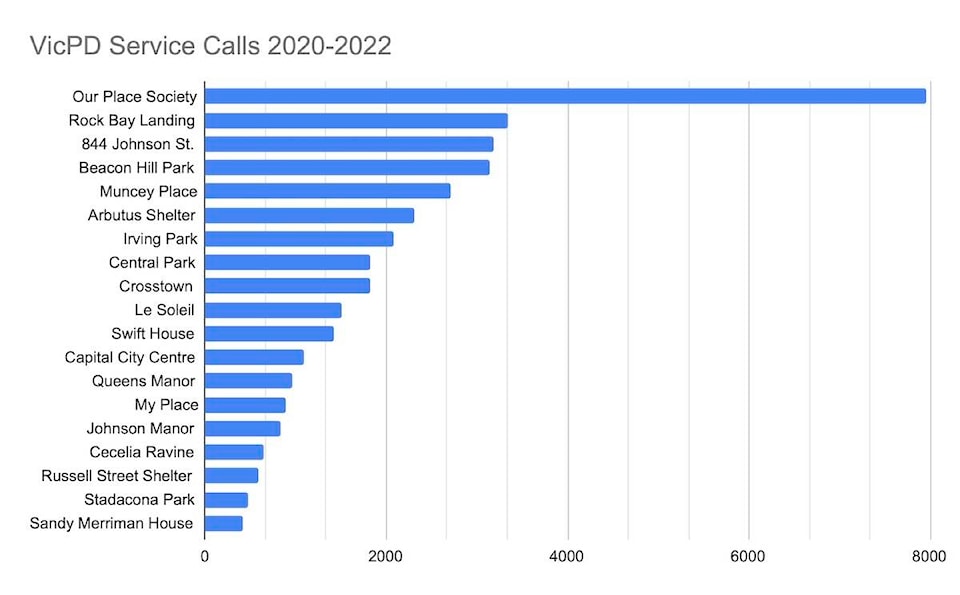Data detailing the number of service calls to 19 Victoria encampments and shelters from 2020 to 2022 has been released following a freedom-of-information request filed by Coun. Stephen Hammond.
But not everyone agrees about what the data really means.
The data revealed VicPD responded to a total of 29,234 calls — an average of 5.4 calls per day — to these 19 areas within the three-year span. The 900-block of Pandora Avenue topped the list with 7,960 calls, followed by Rock Bay Landing with 3,337 and 844 Johnson St. with 3,185.
These 19 locations were responsible for 24 per cent of all police calls in 2022, Deputy Chief Jason Laidman told Hammond in July.
Hammond said the numbers reflect the concerns he’s heard residents voice about the dangers and disturbances they face living near these locations, and reinforce the need for enhanced security. But Grant McKenzie at Our Place Society said calls to service aren’t all criminal, and the way the data is presented tells a false narrative.
Hammond first acquired the data when he brought a motion forward to council directing staff to look into enhanced security around the city’s parks and shelters. The motion was defeated 6-2 at a committee of the whole meeting on July 6.
After he discovered some of his fellow councillors had been in possession of the data several months prior, he filed an FOI request on July 10 to release the numbers to the public.
Hammond said the numbers “confirm what people already know” about the safety concerns people who live in and around these locations face.
“When I talk to people who live in and around these facilities, whether it’s Our Place or the other 19 different places including parks, this is where people are being threatened, where people are being attacked, people are fearful to walk down the street.”
But McKenzie at Our Place Society said the emphasis on crime in the way the data was presented “paints a false picture,” adding many of the calls for service are for welfare checks, overdoses and mental health assists.
“Calls for service have a very different connotation,” he said. “Unfortunately the way (the data) was presented, many people were thinking they were all crimes, but you can also look at it in a separate way in that every one of those calls could have saved a life.”
He said he was not shocked to find the 900-block of Pandora Avenue at the top of the list with nearly 8,000 calls in the three-year span, but he urged Victorians to approach the numbers as a reflection of the serious addiction and mental health crisis happening on the streets.
“The people who are on the street are really among the most vulnerable because they’re just in pure survival mode,” he said. “They’re stuck in this addiction cycle and the severe mental health issues are just staggering, so of course that’s where the most calls are going to go.”
Black Press Media analyzed the 29,000 rows of data compiled by VicPD, with each call broken up by date, location and classification, and found a variety of classifications ranging from suspected criminal activity to well-being checks. A VicPD spokesperson said in a statement to Black Press Media that call classifications are determined by the call-takers, and may not always be what the call turns out to be once the officer arrives on scene.
Responses to criminal behaviour such as “break-and-enter in progress,” “assault” and “weapon” were on the list, as well as wellness and medical responses such as “check wellbeing,” “overdose” and “assist mental health act.” Other ambiguous classifications included “property,” “unwanted person” and “assist general public.”
“Unwanted person” and “assist mental health act” were the most common classifications, each with more than 1,000 calls on the 900-block of Pandora within the three-year span.
An unwanted person classification is defined as “a call placed by an owner or representative regarding a person they do not want on the property who has been asked to leave or refused, or who they feel unsafe asking to leave,” according to VicPD, who added the person has usually moved on or will comply once they are asked to leave by an officer.
After having his original motion defeated, Hammond said he will continue to look for other measures his councillor colleagues might be interested in supporting to “take away the fear and the reality of the crime and disorder in and around shelters and park and street encampments.”
But McKenzie warned enhanced security will not be an adequate solution.
“Enhanced security is one of those sound bites that sound great, but I think Stephen Hammond wants Batman on the streets, and that doesn’t exist. I think that’s the challenge,” he said. “The only way to stop criminality is to house people and to give them the health care they need. We’re talking about not just physical health, but mental health.”
Both Hammond and McKenzie agreed the municipal level doesn’t have the resources or jurisdiction to address homelessness and addiction and needs support from the provincial and federal levels.
“It’s shameful that the premier and others are turning a blind eye to this, and they should be stepping up. They know more stats than I do, and they know what’s going on, and they should actually be giving protection to Victorians,” Hammond said.
“The biggest part the municipal government can do is be a strong, united voice that says, ‘We’re fed up and we need the province’s help,’” McKenzie added.
READ MORE: 49-year-old woman’s body recovered from Thetis Lake Regional Park waters
